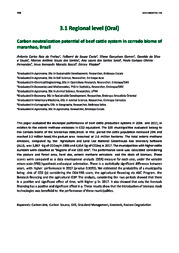Carbon neutralization potential of beef cattle system in Cerrado biome of Maranhao, Brazil.
Carbon neutralization potential of beef cattle system in Cerrado biome of Maranhao, Brazil.
Autoria: FREITAS, A. C. R. de; COSTA, F. de S.; GOMES, E. G.; SOUZA, G. da S. e; SANTOS, M. A. S. dos; SENA, A. L. dos S.; FERNANDES, P. C. C.; BACA, J. F. M.; KLEPKER, D.
Resumo: This paper evaluated the municipal performance of beef cattle production systems in 2006 and 2017, in relation to the enteric methane emissions in CO2 equivalent. The 109 municipalities evaluated belong to the Cerrado biome of the Maranhao state,Brazil. In this period the cattle population increased 20% and reached 3.3 million head; the pasture area remained at 2.6 million hectares. The total enteric methane emission, computed by the Agriculture and Land Use National Greenhouse Gas Inventory Software (ALU), was 3,867 Gg of CO2eq in 2006 and 4,654 Gg of CO2eq in 2017. The municipalities with higher cattle numbers were classified as ?Regions of net CO2 sink?. The performance score was calculated considering the pasture and forest area, herd size, enteric methane emissions and the stock of biomass. These scores were computed as a data envelopment analysis (DEA) measure for each year, under the variable return scale (VRS) hypothesis and output orientation. There is a statistically significant difference between years, with higher performance in 2017 (p-value 0.0193). We estimated the probability of a municipality being sink of CO2 (p) considering the DEA-VRS score, the agricultural financing via ABC Program, the livestock financing and the agricultural GDP. The analysis, considering the two periods showed that there is a positive and significant effect of time, with higher p in 2017. It also showed that only the livestock financing has a positive and significant effect in p. These results show that the introduction of biomass stock technologies was beneficial to the performance of these municipalities.
Ano de publicação: 2019
Tipo de publicação: Resumo em anais e proceedings
Unidade: Embrapa Maranhão
Palavras-chave: Bioma Cerrado, Carbon sinks, Carbono, Degradación del suelo, Deterioração do Solo, Efecto invernadero, Efeito Estufa, GEE, Gado de Corte, Gases de invernadero, Grazing management, Greenhouse effect, Greenhouse gases, Manejo de pastoreo, Maranhão, Metano, Pastagem, Pastizales, Pastures, Reservorios de carbono, Sistema de Produção, Soil degradation
Observações
1 - Por padrão são exibidas publicações dos últimos 20 anos. Para encontrar publicações mais antigas, configure o filtro ano de publicação, colocando o ano a partir do qual você deseja encontrar publicações. O filtro está na coluna da esquerda na busca acima.
2 - Para ler algumas publicações da Embrapa (apenas as que estão em formato ePub), é necessário ter, no celular ou computador, um desses softwares gratuitos. Sistemas Android: Google Play Livros; IOS: iBooks; Windows e Linux: software Calibre.
Acesse outras publicações
Acesse a Base de Dados da Pesquisa Agropecuária (BDPA) para consultar o acervo completo das bibliotecas da Embrapa.

